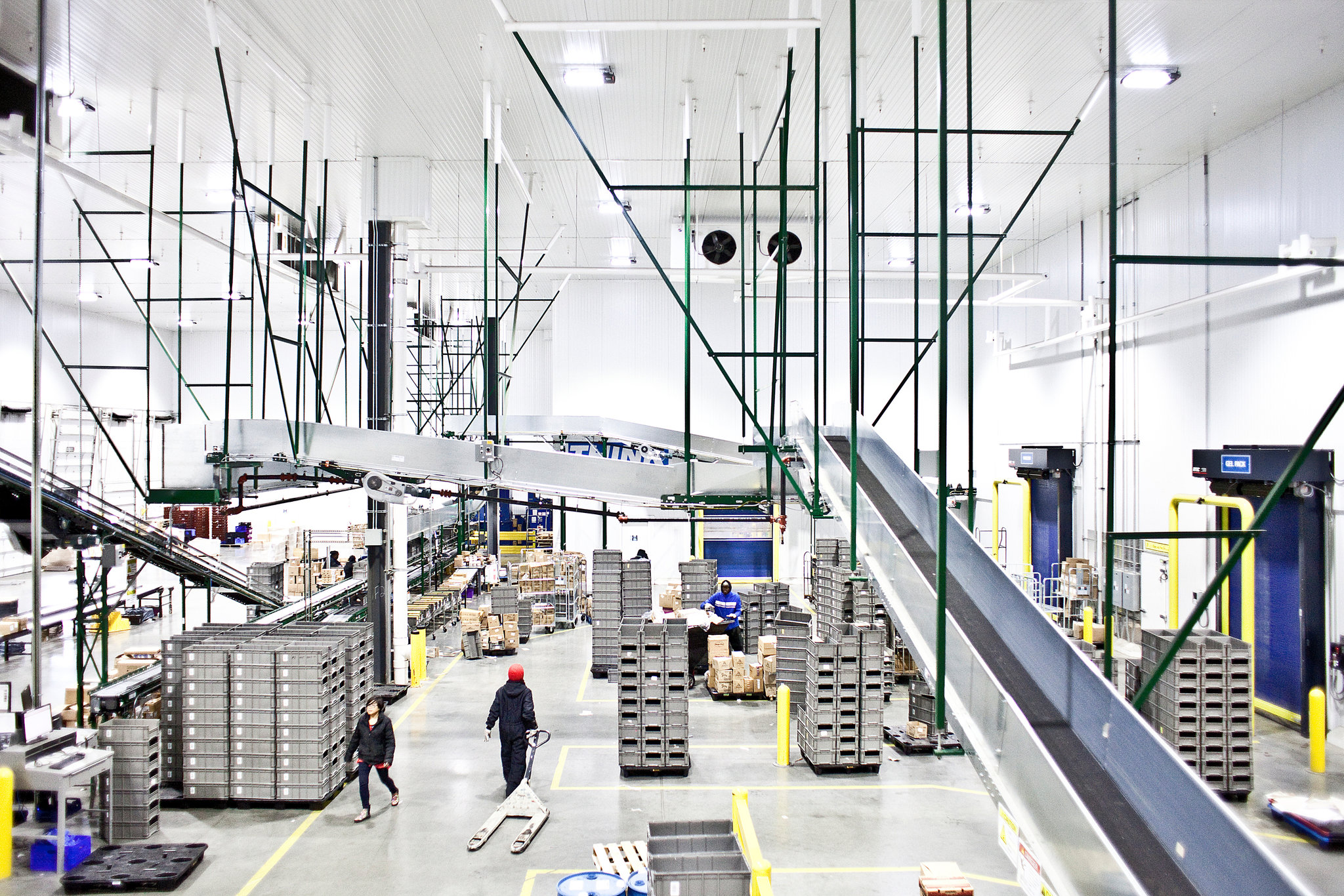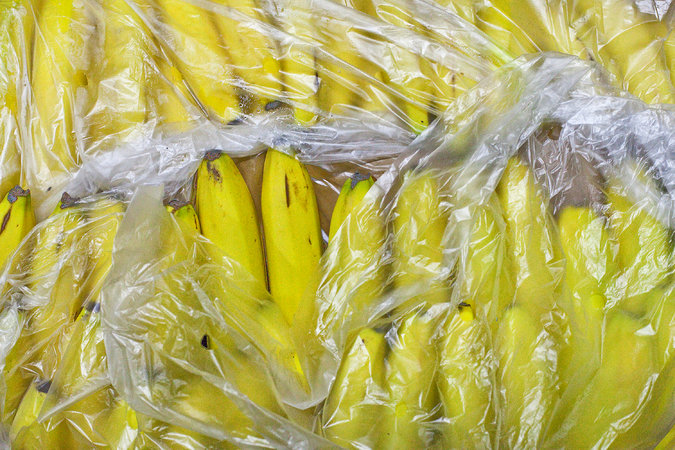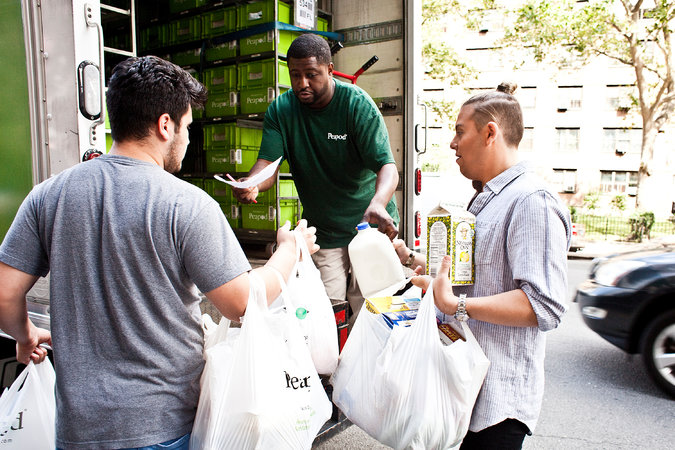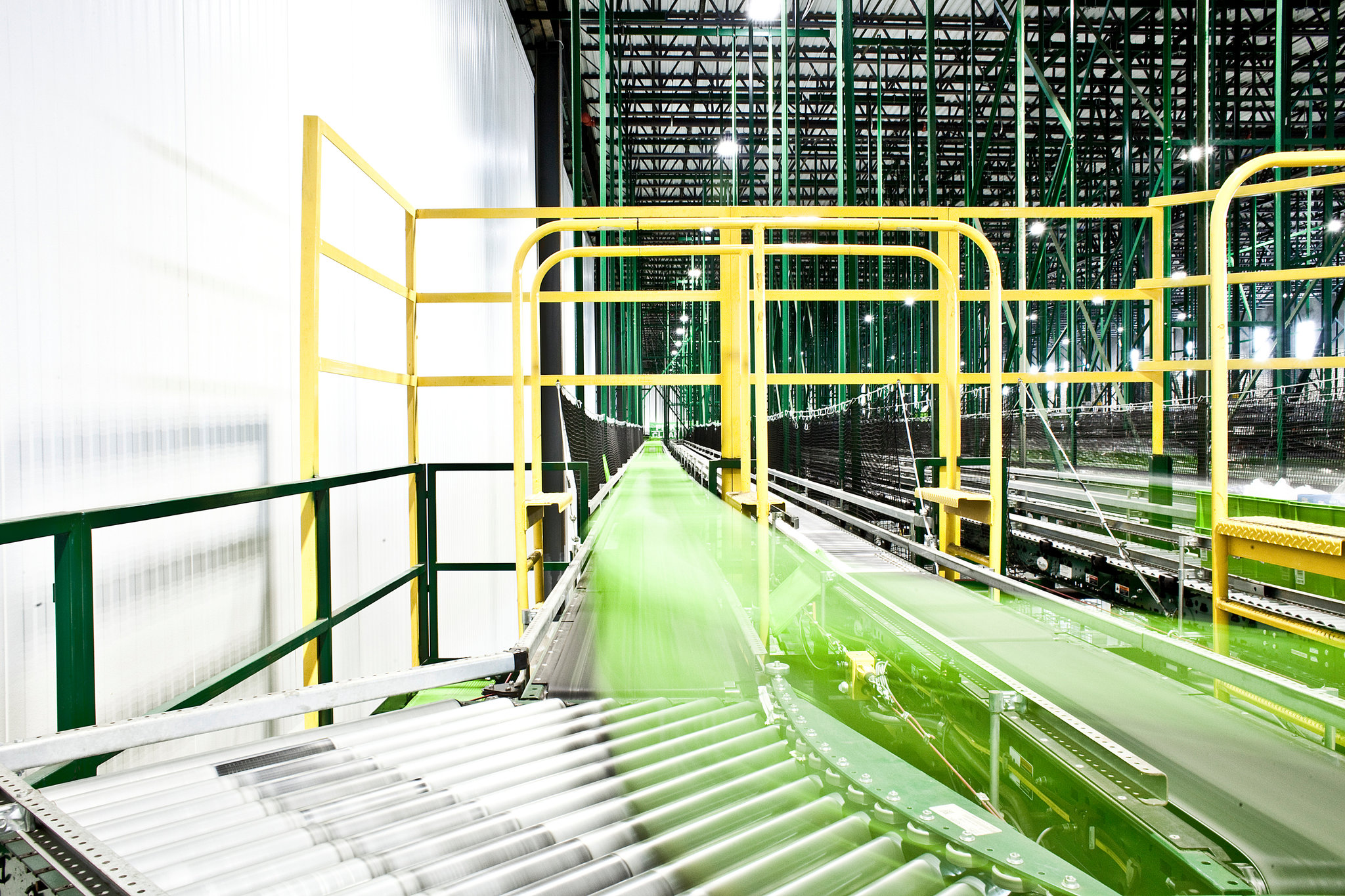NY Times: A Street Fight Among Grocers to Deliver Your Milk, Eggs, Bananas

The Peapod driver Sinclair Browne carries a delivery order to a customer on the Upper East Side. Credit Bryan Anselm for The New York Times
By RACHEL ABRAMS | JUNE 24, 2017
Every couple of days, Sinclair Browne fights through traffic in Times Square, squeezes his delivery truck into a parking spot, walks up four flights of stairs and delivers groceries to a guy whose order he knows by heart.
“I’m fast,” said Mr. Browne, slicing his hands in the air, ninja style. “In and out, in and out.”
Delivering food requires military precision: Bananas can’t get cold. Produce can’t get warm. Eggs, of course, must not get broken. And people expect their food to arrive at specific times.
Mr. Browne, 40, is a driver for the online grocery business Peapod. He plays the most important role in solving the biggest problem vexing the online grocery industry: moving food, undamaged and unspoiled, from the warehouse to the customer’s house. It’s known as the last-mile problem.
Delivering perishables is much trickier than delivering T-shirts, books or pretty much anything else people can buy online. The biggest challenge is that groceries must stay cold for hours at a time. But there are myriad other complications, too. Bananas and apples give off fumes that can hurt loose leaf lettuce, so they can’t be stored too close. Tomatoes lose flavor when they cool to below 55 degrees. Milk always has to be packaged upright.
All the complexity adds costs in an industry where profit margins are already thin. Few businesses have attempted these kinds of gastronomic acrobatics on a large scale, and numerous start-ups have failed trying, making groceries the last frontier of online shopping.
Even Amazon, which built a multi-billion-dollar business by perfecting its delivery logistics, hasn’t quite mastered the art of profitably delivering perishable food in big metropolitan areas. But it just made a big bet, purchasing Whole Foods in a $13.4 billion deal that will give it access to more than 400 stores concentrated around major population centers — places that may have walk-up apartments, aggressive taxi drivers and other urban obstacles that Mr. Browne navigates five days a week.
Amazon’s deal sets up a face-off with Walmart, the nation’s largest grocery store. Walmart itself is struggling to become as dominant in the virtual world as it is in the physical one.
Jennifer Carr-Smith, Peapod’s chief executive, says she hopes Amazon’s purchase of Whole Foods will ultimately encourage more people to shop for groceries online, where about 10 percent of all shopping in the United States happens now. The numbers for food are less than half that, according to data from FMI-Nielsen.
As the competition heats up, Amazon and others will be relying on drivers like Mr. Browne, who makes $13 an hour, plus tips, to handle the biggest challenges of succeeding in the online grocery business.
“What’s up, boss?” Mr. Brown greets the doorman at his first building, who tells him he’ll need to take his cart to the service entrance. He takes the elevator down one flight, but it’s the wrong entrance.
He tries another floor. No go.
When he asks for directions, the man working at the service entrance yells at him: “You don’t know, you should tell me you don’t know!”
But rudeness, Mr. Browne says, is just one of the things he has to deal with. He’s still got to get in and out, in and out. Nineteen stops to go.
The Warehouse

Conveyor belts and sorting areas at Peapod’s warehouse in Jersey City. Credit Bryan Anselm for The New York Times
Every second counts. Grocery delivery companies like Peapod have to calculate exactly how long each individual order will take, and monitor traffic patterns and car accidents for any disruptions. Mr. Browne gets alerts on his phone; on Sunday, he’ll have to avoid crossing Fifth Avenue, because of the Pride parade.
Today, some of his orders are allotted 10 minutes, others 12. Urban areas tend to take longer per stop: 12 to 20 minutes on average, compared with eight to 14 minutes in the suburbs, where Mr. Browne can pull right up to people’s homes.
For all 20 of his orders on this day, Peapod has allotted nine hours and 20 minutes. Mr. Browne thinks he can do them all in eight.
“The first guy slowed me up by having to go through the loading dock. I never really went through there before,” Mr. Browne says as he drives to the next stop. “Usually I’d be in and out of that building.”
His truck was loaded at Peapod’s warehouse in Jersey City, a massive 400,000-square-foot facility that services New York and New Jersey. About 425 people bustle in and out of the meat room, the produce room, a rotisserie room filled with dozens of rotating chickens. Workers wearing thick freezer suits retrieve frozen foods from the coldest room, loading items into bright green temperature-controlled bins that workers refer to as “totes.”
Anyone who has shopped for groceries online has probably thought to themselves something like, “Who will be squeezing my tomatoes, and will I get the good ones this time, or not?” That’s why, despite the vastness of the industrial automation here — there are about 7 miles of conveyor belts in Peapod’s warehouse — people like Amal Afifi are important. As she loads the totes, Ms. Afifi personally inspects some of the 14 million bananas Peapod sells each year.

Bananas — one of the biggest sellers for online grocers — wait to be shipped out. Credit Bryan Anselm for The New York Times
Her guidelines are relatively simple: Trust your gut. Literally.
“I shop for customers like I shop for myself,” Ms. Afifi said, pointing to a box of unappetizing-looking, reject bananas. They may get donated to a local zoo, where the animals are less picky than people are about bruised fruit and smushed bread.
Once perishable items make it into the tote, the clock starts ticking. Keeping food cold until it gets to customers is the single most difficult and important thing about delivering groceries. There are many opportunities for things to go wrong.
For all the impersonal convenience that online shopping brings — no crowds, or lines, or chatty cashiers — no company has figured out how to automate away the care that a live human like Mr. Browne needs to show toward the food.
Carrying a box of sodas and two bags of cold food, he walks into the lobby of a building about halfway through his shift. The doorman tells him to leave the order, but he refuses. What if the doorman forgets about it, and the fruit stays out for hours?
“For every hour that you break that cold chain, you lose one day of shelf life,” said Tony Stallone, Peapod’s produce guru, who is described on the company’s website as claiming that “his lettuce talks to him.” (When asked about it, Mr. Stallone laughed it off.)
Peapod has 19 to 21 hours to get totes to customers, and everything has to stay at the right temperature that whole time. If you break the cold chain on the way to a customer’s refrigerator, Mr. Stallone said, even the healthiest-looking berries could rot too quickly.
That potentially undermines one of the main selling points of delivery: the convenience. “If you have a bad apple or a spoiled gallon of milk or broken eggs, we suddenly become inconvenient,” he said.
Mr. Browne goes around to the service entrance instead, where two maintenance men tell him that he can’t use the elevator because they’re doing repairs.
“I can’t leave it with just anybody,” he says, and doesn’t agree to leave until one of the men offers to bring it up to the customer.
“You’ll do it right now?” he asks. “O.K.”
Not every item needs to be cold. In fact, a temperature below 58 degrees will destroy the bananas that Ms. Afifi picked out.
FreshDirect, one of Peapod’s competitors, wraps its bananas in little sleeves to keep them warm. (FreshDirect cools its entire trucks, while Peapod relies on dry ice, gel packs and other methods of controlling the temperature in each individual tote.)
“When it leaves the store, when it leaves the warehouse to get to you, that’s the issue,” said Phil Lempert, a grocery retailing expert. “They can estimate within seconds of how long it takes to get from the truck to your house for a delivery.”
The City
Mr. Browne knows which doormen will let him use the bathroom, which customers tip well and which buildings will force him to use the service entrance, even if he’s only carrying a couple of bags.
Delivering perishable groceries is still largely an urban business, where logistics can be a nightmare. There are fewer places to park, more steps to climb and more garage doors to accidentally block. Mail carriers have offered some lessons for Peapod’s competition; FreshDirect, for example, copies the UPS model of parking in one spot all day, and using multiple people to make multiple deliveries at a time.
On his way into one building, Mr. Browne passes a cart full of FreshDirect groceries on the sidewalk.
Unlike FreshDirect deliverymen, Mr. Browne works alone in his truck, and he has to move it for each delivery. Parking tickets are a cost of doing business, and Peapod even has a line item on the budget for fines and tolls. But moving around in a dense urban area has other challenges.
“It’s a lot of traffic, real tight spaces, a lot of people, people will just cross right in front of the truck sometimes,” Mr. Browne says. “Working in the city is very difficult, that’s why they say it’s not for everyone.”
As he drives, Mr. Browne scans the road for buses, cabs, pedestrians and even horses. Peapod drivers get a couple of hours of defensive driving training, and Mr. Browne keeps an eye on a camera that shows what’s happening directly behind him. That helps him spot skateboarders who sometimes try to catch a free ride by grabbing his bumper.
“That’s dangerous, because if I turn,” he said, “that guy is basically dead.”
Once he makes it through Times Square, things get a little easier. Today he’s mostly going to residential buildings with elevators, where people tend to tip better, inexplicably, than people who live in walk-ups.
“You have some customers where they have an elevator, they have a doorman, and they could have three bags, give you $20,” says Mr. Browne, who has been working overtime to save up for a birthday party for one of his three children. “I say, ‘Thank you, this goes to my daughter’s sweet 16.’”
Mr. Browne likes interacting with customers. He has families, college students, older people who he feels he’s helping, because they can’t easily shop for themselves. There’s the woman who lives directly above a grocery store, but still orders online. There’s the man who orders Froot Loops or cold cuts every couple of days, the woman who tips $20 every time.
Today, he’ll deliver to a couple of college students who must meet the truck outside. For security reasons, their dorm won’t let delivery drivers upstairs.

On the Upper East Side, some of Mr. Browne’s customers meet him at his truck. Credit Bryan Anselm for The New York Times
Younger people are especially important to grocery delivery companies. Millennials and Generation Y make up about a quarter of Peapod’s customers, but in a few years those young people will likely begin spending more money on food; maybe they’ll have families, or get a pet, or start making a little more money.
They have grown up in an environment where everything is available online, and digital grocers want to get them hooked early. Peapod, for example, has added more organic, international and bulk items to its offerings, because those products tend to be popular among its younger customers.
Generation X makes up about half of Peapod’s customers, and the remaining 25 percent are older. In total, Peapod’s customers are fairly evenly divided between the city and the suburbs, where Mr. Browne prefers to work. There are no horses or walk-ups, and he doesn’t need to walk past the garbage at a service entrance.
Though the distances are longer, non-metro areas tend to be cheaper places for Peapod to work, according to Ken Fanaro, the company’s senior director of transportation planning and development. Fuel efficiency is better, and there are fewer parking tickets and tolls. But because customers are farther away and more widely spaced, drivers can do fewer orders per shift. (Tips, however, tend to be better outside the most densely populated areas, Mr. Browne says. One time he went to Staten Island — part of New York City, but largely suburban in layout — and made $200 over two days.)
“Every day, you’re coming home with money,” he says. “I’ve never had a job like that before.”
About half of Mr. Browne’s customers today chose to tip him online when they placed their orders. Some will tip him in cash. Some, like the college students, won’t tip at all. Today, the man in the fourth-floor walk-up who orders every couple of days tips Mr. Browne for the first time, giving him $3.
“What’s up, boss?” Mr. Browne says to the man at the top of the stairs, slightly out of breath.
Mr. Browne has lost 15 pounds since he started this job about a year and a half ago. Today he is carrying a gallon of milk, laundry detergent and a couple of bags with his left arm, and holds a carton of eggs in his right hand. He tries to do everything in one trip, if he can.
He opens the carton to show the eggs aren’t broken — eggs must always be presented to the customer — and heads back downstairs. In and out.
“What’s up, buddy?” he says to a woman’s cat, for whom he’s carrying two big containers of litter. “This is for you.” He chats with the cat’s owner for a minute as he carries the bags into her apartment, but the small talk can’t take extra time.
Being late isn’t as often a problem for Mr. Browne as is being early. Because the city is so unpredictable, the company frequently allots him more time than he needs. He is one of the fastest drivers who works out of Peapod’s Jersey City warehouse, but he thinks he could do more deliveries.
When he shows up early, he can’t contact the customers directly. Instead, he has to call someone back at the office, who then calls the customer, to see if he can drop off the order ahead of time. If not, he has to wait.
When the opposite happens — when people aren’t home — Mr. Browne can wait only 15 minutes. The other day he had to wait for a woman in a fourth-floor walk-up, carrying three bags in each hand.
“Seven minutes, I could have done another delivery,” he says.


Mr. Browne reminds me of Jurgis Rudkus from Upton Sinclair’s book, The Jungle, or Kenny Dobbins in Fast Food Nation, or most any Uber driver …